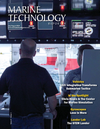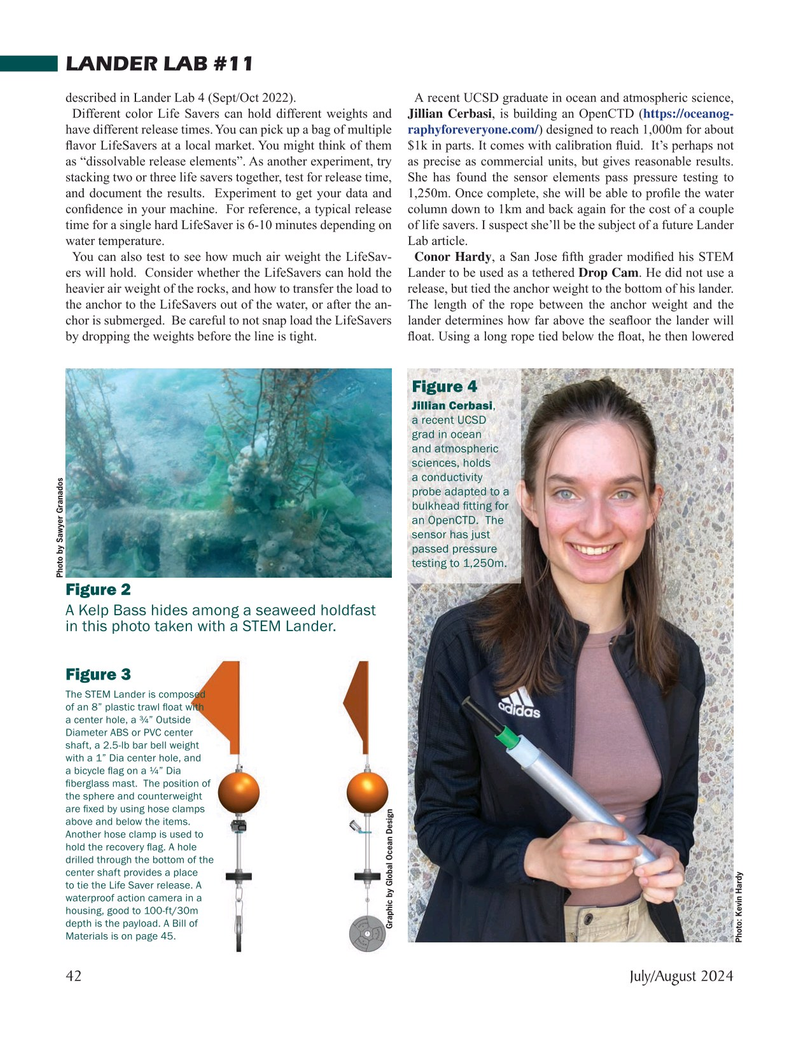
Page 42: of Marine Technology Magazine (July 2024)
Read this page in Pdf, Flash or Html5 edition of July 2024 Marine Technology Magazine
LANDER LAB #11 described in Lander Lab 4 (Sept/Oct 2022). A recent UCSD graduate in ocean and atmospheric science,
Different color Life Savers can hold different weights and Jillian Cerbasi, is building an OpenCTD (https://oceanog- have different release times. You can pick up a bag of multiple raphyforeveryone.com/) designed to reach 1,000m for about ? avor LifeSavers at a local market. You might think of them $1k in parts. It comes with calibration ? uid. It’s perhaps not as “dissolvable release elements”. As another experiment, try as precise as commercial units, but gives reasonable results. stacking two or three life savers together, test for release time, She has found the sensor elements pass pressure testing to and document the results. Experiment to get your data and 1,250m. Once complete, she will be able to pro? le the water con? dence in your machine. For reference, a typical release column down to 1km and back again for the cost of a couple time for a single hard LifeSaver is 6-10 minutes depending on of life savers. I suspect she’ll be the subject of a future Lander water temperature. Lab article.
You can also test to see how much air weight the LifeSav- Conor Hardy, a San Jose ? fth grader modi? ed his STEM ers will hold. Consider whether the LifeSavers can hold the Lander to be used as a tethered Drop Cam. He did not use a heavier air weight of the rocks, and how to transfer the load to release, but tied the anchor weight to the bottom of his lander. the anchor to the LifeSavers out of the water, or after the an- The length of the rope between the anchor weight and the chor is submerged. Be careful to not snap load the LifeSavers lander determines how far above the sea? oor the lander will by dropping the weights before the line is tight. ? oat. Using a long rope tied below the ? oat, he then lowered
Figure 4
Jillian Cerbasi, a recent UCSD grad in ocean and atmospheric sciences, holds a conductivity probe adapted to a bulkhead ? tting for an OpenCTD. The sensor has just passed pressure testing to 1,250m.
Photo by Sawyer Granados
Figure 2
A Kelp Bass hides among a seaweed holdfast in this photo taken with a STEM Lander.
Figure 3
The STEM Lander is composed of an 8” plastic trawl ? oat with a center hole, a ¾” Outside
Diameter ABS or PVC center shaft, a 2.5-lb bar bell weight with a 1” Dia center hole, and a bicycle ? ag on a ¼” Dia ? berglass mast. The position of the sphere and counterweight are ? xed by using hose clamps above and below the items.
Another hose clamp is used to hold the recovery ? ag. A hole drilled through the bottom of the center shaft provides a place to tie the Life Saver release. A waterproof action camera in a housing, good to 100-ft/30m depth is the payload. A Bill of
Graphic by Global Ocean Design
Materials is on page 45.
Photo: Kevin Hardy 42 July/August 2024
MTR #5 (34-47).indd 42 7/25/2024 8:47:02 AM

 41
41

 43
43
